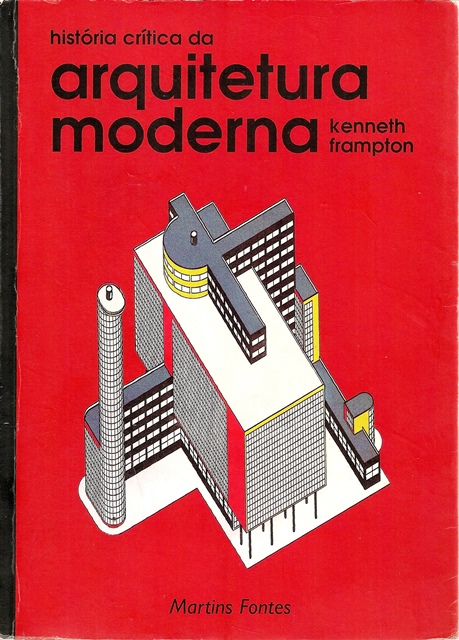Kenneth Frampton Modern Architecture A Critical History Pdf Documents
Jean-Jacques Lequeu’s Monument to the revolution (1791) Two aspects of Kaufmann’s classic account of revolutionary architecture deserve to be mentioned. First, there is the procedure he adopts in attempting to situate architecture and revolution. Rather than assume direct correspondence between them, either according to a linear model of cause and effect or a reciprocal model of mutual causation and effectuation, Kaufmann suggested a more circuitous and indirect link. In other words, architecture neither brings about revolution by itself nor prevents it from coming about, and vice versa.
Still less could the matter be resolved simply by asserting that they simultaneously codetermine one another. Kaufmann instead contended the apparent isomorphism of moral and architectural conceptions of autonomy during this period arose out of their common participation in its revolutionary Zeitgeist.

Genre/Form: History. Additional Physical Format: Print version: Frampton, Kenneth. Modern architecture. New York: Oxford University Press, 1980 (DLC) 79021554 (OCoLC)5497803. Material Type: Document, Internet resource. Document Type: Internet Resource, Computer File. All Authors / Contributors: Kenneth.
A materialist would only add that this radical spirit of innovation he perceived was but the ideological reflection of real historical dynamics. Posted in, Tagged,,,,,,,,. Sammy Medina and Ross Wolfe. Saturday, June 8th, 2013 Center for Architecture Museum of Modern Art New York, NY Originally published at was billed as a two-day international symposium focusing on the architect’s to the city, and featured such luminaries within the field as Jean-Louis Cohen, Kenneth Frampton, Peter Eisenman, Stanislaus von Moos, and Mary McLeod, along with a host of other lesser-known critics and historians. Jointly organized by the Center for Architecture together with the Museum of Modern Art, the event was held at the former’s downtown headquarters on the occasion of the latter’s upcoming exhibit, Le Corbusier: An Atlas of Modern Landscapes. Barry Bergdoll, the chief curator of architecture and design at MoMA, was on hand to preside over several rounds of the discussion.

With headlining acts like these, the space was predictably packed to the gills. Somewhere around two hundred people attended the symposium. Le Corbusier in New York, 1946 Beneath this general rubric of Corbusier’s relationship to New York City, the quality of the presentations varied widely. The first batch was composed of papers decidedly more academic, even scholastic, in character. Of these first few twenty-minute talks (though they frequently ran over time), the one by Mardges Bacon “On the Streets of the Vertical City: Le Corbusier in New York, 1935” was perhaps the most compelling. In all likelihood, this owed its fidelity to the historical record of Corbusier’s actual visit to the city in that year, rather than to speculation about the impact the city might have had in concept — in the abstract. Bacon carefully traced his ambivalent impressions of New York as he encountered it in person for the first time, no longer forced to make do with the visual descriptions or the photographic documentation of others.
She explained the great modernist’s awe before the sheer verticality of Manhattan, and his profound admiration for skyscrapers’ use of the latest building materials and techniques. In Corbusier’s view, the real tragedy was that such modern methods were forced to fit the framework of such antiquated zoning laws.
Posted in,,, Tagged,,,,,,,,,,. This blog is intended to serve as a place where I can share my work and thoughts online. On the one hand, it will provide a convenient place for me to store an online portfolio for future reference. At the same time, I am interested in connecting and engaging with others who are interested in the subjects it covers. Needless to say, all of the opinions expressed on my blog are mine alone, unless otherwise indicated. They do not necessarily reflect the views of any other group or organization.
No one else is responsible for them. That being said, any comments, questions, and criticisms are welcome. Pictures at an exhibition. The twin fires of war and revolution have devastated both our souls and our cities. The palaces of yesterday’s grandeur stand as burnt-out skeletons.
The ruined cities await new builders[] To you who accept the legacy of Russia, to you who will (I believe!) tomorrow become masters of the whole world, I address the question: with what fantastic structures will you cover the fires of yesterday?” ⎯ Vladimir Maiakovskii, “An Open Letter to the Workers” (1918) “Utopia transforms itself into actuality. The fairy tale becomes a reality. The contours of socialism will become overgrown with iron flesh, filled with electric blood, and begin to dwell full of life. The speed of socialist building outstrips the most audacious daring. In this lies the distinctive character and essence of the epoch.” ⎯ I. Chernia,“The Cities of Socialism” (1929) “The idea of the conquest of the substructure, the earthbound, can be extended even further and calls for the conquest of gravity as such.
It demands floating structures, a physical-dynamic architecture.” ⎯ El Lissitzky, The Reconstruction of Architecture in the Soviet Union (1929) Menacing rectilinear shapes Meta • • • • Stats • 10,843,557 visits.